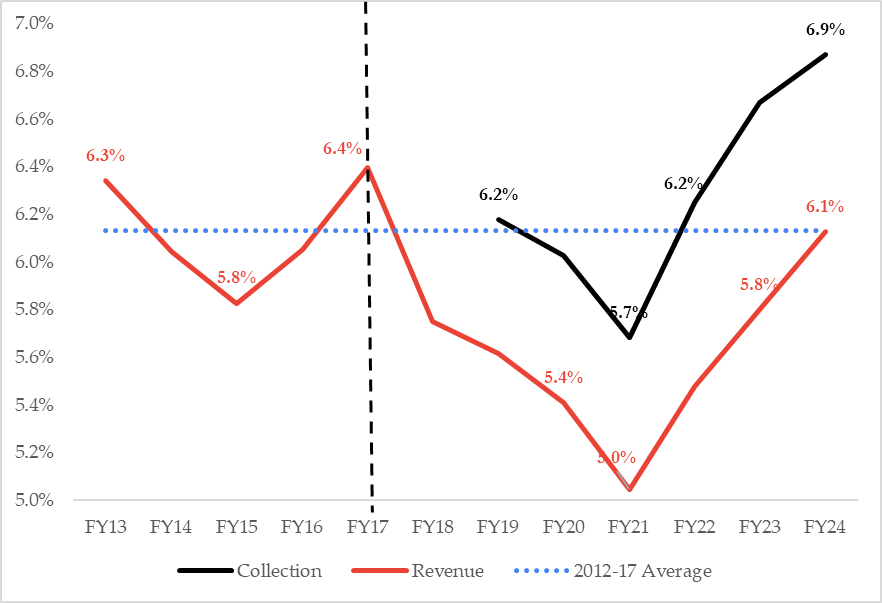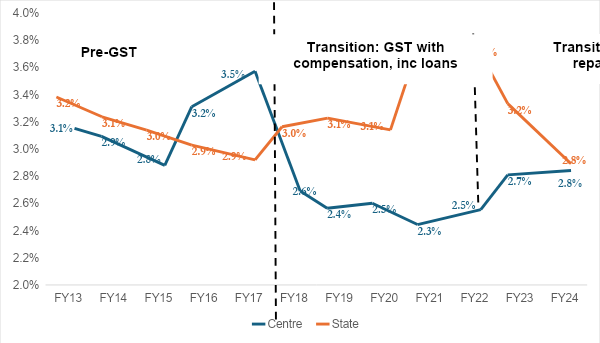
Business Standard, 7 min read Last Updated : Jul 03 2024 | 12:47 AM IST
It has now been seven years since the Goods and Services Tax (GST) was introduced. The transitional compensation mechanism has expired; the loans taken during Covid will soon be repaid; and the fate of the compensation cess needs to be decided. So now is a good time to review the GST’s revenue performance and assess its future.
Our new research yields some findings that are relevant for the debate over the GST’s future. In particular, it shows that the centre has foregone substantial revenue over the past seven years, a contribution that has been overlooked in the often-heated discussion of GST performance. Until now, this contribution has neither been quantified, nor (perhaps for this reason) has it been generally appreciated.
The under-performance of GST revenues is key to understanding the extent of the center’s contribution. As a result, the states have tapped the revenue guarantee that the centre provided at the time of the tax’s inception. This was done to convince the states, naturally anxious about giving up some fiscal sovereignty, to agree to the reform. And this, in turn, has meant that less GST revenue has flowed into the centre’s coffers.
Start with the data on GST revenue. It is true that gross collections have been extremely buoyant over the past few years (black line in Figure 1). But as we first pointed out last December in these pages, the more relevant net revenues-GDP ratio (red line) has only now converged to the revenues collected from equivalent taxes in the pre-GST regime. In 2023-24, net government GST revenues (both centre and state, including the cess) amounted to Rs 18 lakh crores or 6.1 percent of GDP, about the same as the pre-GST 2012-17 average (blue line).
Figure 1. GST: Gross Collections versus Net Revenues, FY13-FY24 (% of GDP)

Source: NIPFP, RBI and budgets of center and states. Pre-GST revenues relate only to taxes subsumed under the GST. These revenues are over-stated to the extent of the build-up of refunds which were only cleared in the GST era. These refunds accumulated over time and cannot be easily quantified but should not materially change our findings. FY24 refers to the fiscal year 2023-24 and so on.
The difference between gross collections and net revenues is explained by refunds which the government has had to pay, mostly to reimburse exporters for the GST they had paid on their supplies. These refunds (data for which was first published in February 2024) are non-trivial in magnitude, amounting to Rs 1.8 lakh crore in 2023-24 or nearly half a percentage point of GDP.
Why have net revenues been disappointing? Essentially, because many of the initial rates have been cut, especially between 2017-18 and 2019-20. Just to take a few examples, rates were reduced on electric appliances, fans, furniture, mobile phones, cosmetics, detergent, and even honey. For the period FY21 relative to FY18, Professor Mukherjee of NIPFP estimates that the effective tax rate went down from 13.2 percent to 10.8 percent, resulting in a revenue loss of Rs. 1.25 lakh crores.
Of course, there is a more positive way to describe revenue performance. One could say that the GST has managed to sustain government revenue, even as rates have been reduced, benefitting consumers. Improvements in collection efficiency and favorable composition effects—towards imports—probably helped.
In any case, because overall revenue performance belied expectations, states have drawn heavily on the guarantee the centre provided at the time of the 2017 reform, which assured states that their revenues would grow by 14 percent annually for a period of 5 years. To fund the guarantee, a cess was introduced on “de-merit goods,”such as tobacco, aerated drinks and motor vehicles. When Covid hit in 2020, economic activity and revenues collapsed, leaving the fund far short of the resources needed to fill the sizable revenue shortfalls in the states. In response, the fund borrowed about Rs 2.75 lakh crores, an amount which is now being repaid from cess collections.
Hence, cess collections were devoted to funding the 14 percent compensation guarantee for the first five years, then repaying the loan in the last two years. The result was that virtually nothing was left for the centre over the entire seven-year transition.
Figure 2 shows the effect on the distribution of revenues. For the five years when the guarantee was still in effect, overall GST revenues declined (Figure 1) as well as those of the center (blue line in Figure 2), but the states enjoyed a small fiscal bonanza (red line). Then, in the most recent two years, when states also ceased to receive anything from the compensation cess, their revenues fell sharply even as overall GST revenues boomed.
Figure 2. Sharing of GST Revenues, FY13-FY24 (% of GDP)

Source: GST Portal and RBI. RE Estimates for FY24 have been adjusted to reflect the historical ratio of revenues (excluding the cess) accruing to the center and states. Due to rounding-up errors, figures in Figure 2 may not exactly match those in Figure 1.
Clearly, then, the states gained from transition while the centre lost. But exactly how much were these gains and losses? Answering that question requires a framework, set out in the Table. We compare actual collections relative to two benchmarks: average revenues pre-GST; and the revenues if the pre-GST arrangements and associated buoyancy had remained in place during the GST transition period. Admittedly, making these comparisons involves some assumptions, but the results are reasonably robust (and described in our forthcoming paper).
Our framework suggests the centre lost significant amounts of revenue because of the transitional arrangements, between 0.6 percent and 1 percent of GDP every year (depending on the comparison and assumptions) during the 7-year transition.
Meanwhile, the states gained between 0.2 percent and 0.6 percent of GDP annually, although it could have gained more if the states did not have to contribute to the repayment of Covid loans in the last two years. In addition to the compensation guarantee, the states also benefitted from getting access to the more buoyant services tax base. As can be seen in Figure 1, the centre’s revenues pre-GST were much more buoyant than the states. (Recall that under the previous arrangements, state indirect taxes fell mainly on goods while only the centre taxed services.)
Table. Gains and Losses During Transition, Centre and States
(% of GDP; average for FY18-FY24)

1.Because of the surge in the centre’s revenues in the years FY2015 and FY2016, the average buoyancy amounted to about 1.4 for the pre-GST regime but this could be over-stated because uncleared refunds overstate true revenues. Therefore, we assume that this buoyancy would have been in the more realistic range of 1-1.1 during the transition period.
Over the past few years, most commentators have rightly emphasized the tensions in centre-state fiscal relations, pointing especially to the centre’s repeated recourse to non-sharable cesses. But against these actions should be set the experience of the GST, where the centre made a large sacrifice on behalf of—and to the benefit of—the states. This example should not be ignored, for it is a shining example of cooperative federalism.
A more subtle conclusion emerges from this experience. We have long argued that as India becomes more integrated the risk of common shocks affecting all the states rises. Covid was a perfect illustration. As a response to this market integration, the fiscal federal arrangements require more counter-cyclical transfers to the states that can borrow less easily than the Center. Unwittingly, the 14 percent compensation guarantee under the GST turned out to be a spectacular counter-cyclical transfer benefitting the states without which the Covid shock might have been devastating for their finances. That unintended consequence needs to become embedded as a feature not an accident of fiscal federalism.
This past is now prologue. Once the Covid-era loans are repaid, the GST will enter a new steady state. What should then happen to the compensation cess -- and how will that decision affect the centre and the states? We discuss these tomorrow.
Disclaimer: The article first appeared in Business Standard. The publication details along with the link to the original publication is given above.

